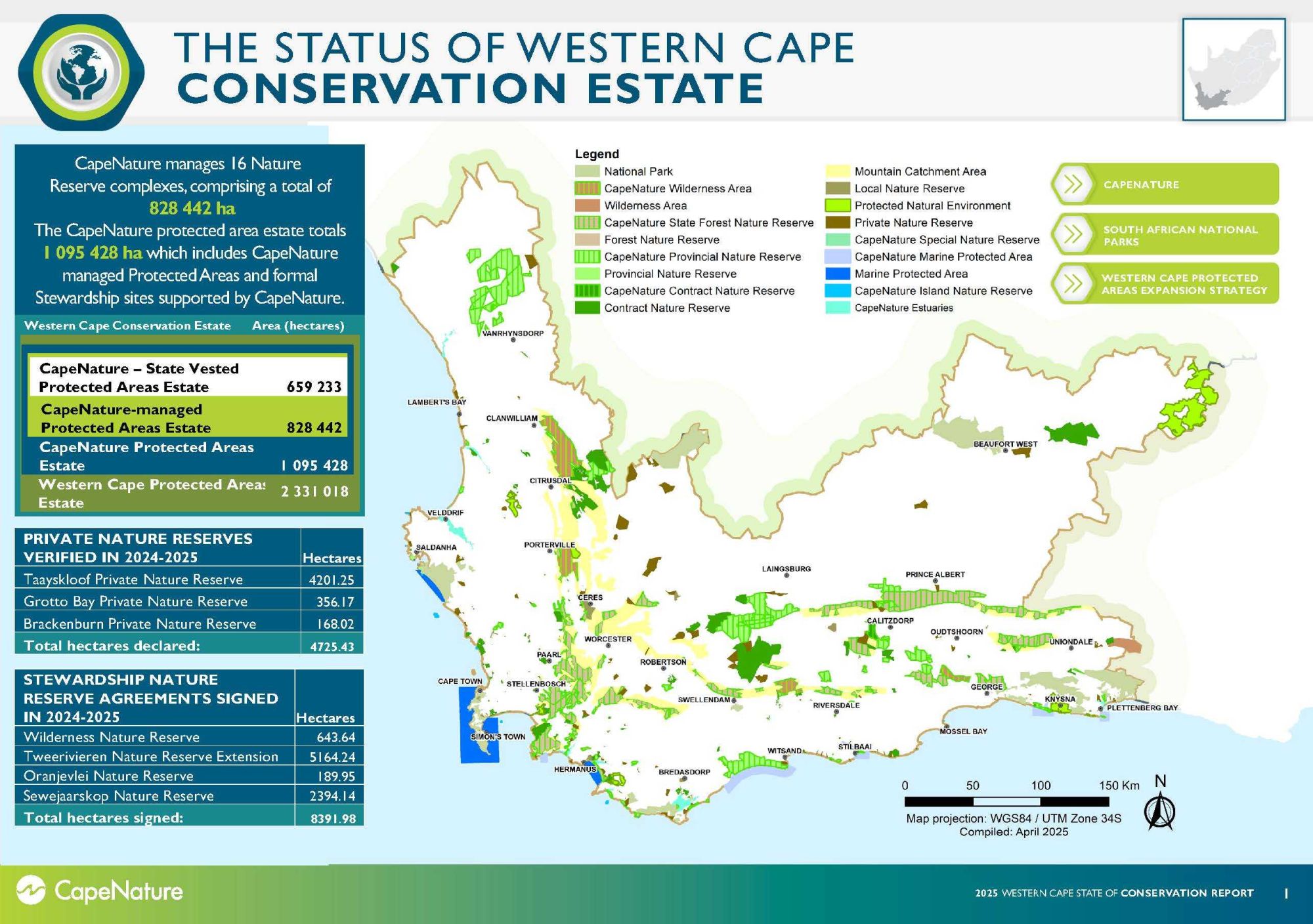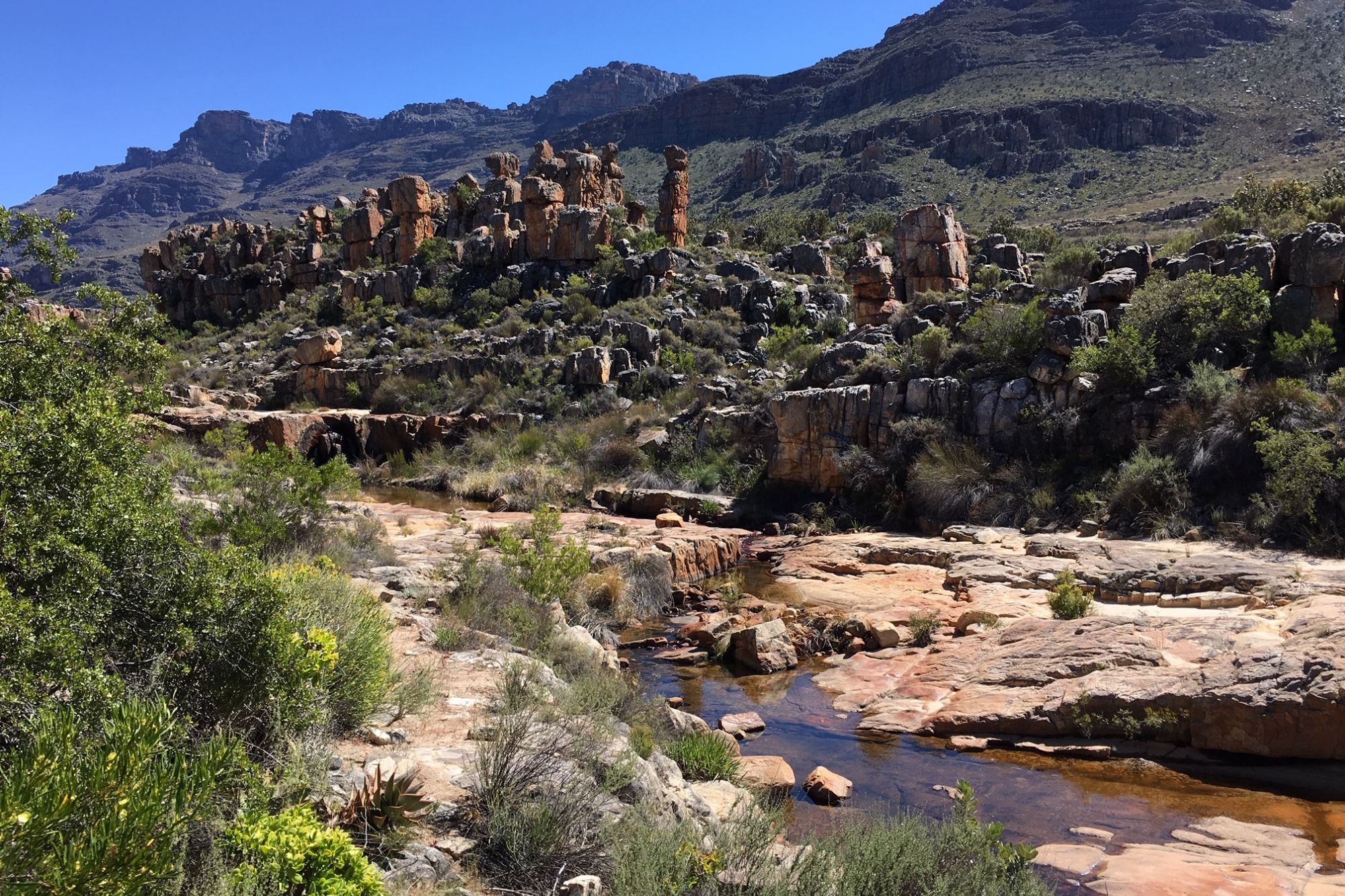Protected areas and stewardship
CapeNature protected areas
CapeNature’s protected areas are important for conserving ecosystems and species, as well as for socioeconomic upliftment through job-creation opportunities, particularly in rural areas. They serve to protect the ecosystems that deliver important related services to people.
CapeNature manages 16 nature reserve complexes, comprising a total of 828 442 ha, which includes 42 739.31 ha of marine protected areas. Thirteen protected area complex management plans have been approved to date, with two new management plans for the Greater De Hoop Complex and Betty’s Bay Marine Protected Area being drafted. Protected areas managed by CapeNature are of extremely high biodiversity conservation value.
The CapeNature protected area estate, totalling 1 095 428 ha, includes CapeNature-managed protected areas and formal stewardship sites supported by CapeNature. The Western Cape protected area estate comprises approximately 2 331 018 ha, including national parks, local authority nature reserves, mountain catchment areas, protected environments, private nature reserves and marine protected areas.

CapeNature conservation estate (source: 2025 State of Conservation Report).
CONSERVATION STEWARDSHIP
The Western Cape’s landowners can play an important role in the conservation of our natural heritage.
CapeNature works in partnership with private landowners, communities, agricultural businesses and other stakeholders to ensure biodiversity survives in a changing climate outside protected areas with tangible benefits to the local communities and shareholders.
As most of the province’s biodiversity is in private ownership, CapeNature initiated the Biodiversity Stewardship programme in 2003. This programme facilitates conservation on privately owned land by setting up agreements between the landowners and CapeNature.
Landowners undertake to protect and manage their properties or parts thereof according to sound conservation management principles. CapeNature undertakes to support this management by providing advice, management plans and assistance in planning invasive alien species clearing and fire management schedules. It also allows for the private landowner to benefit more from the biodiversity through ecologically sensitive income-generating avenues such as eco-tourism or green labelling of agricultural produce (e.g. Business and Biodiversity Initiatives).
Why should you become involved?
• You can assist in achieving the provincial and national conservation targets for threatened species and ecosystems;
• Better management of natural resources will contribute towards securing the future for society, through improved water quality and production in catchments, and reduced erosion and flooding;
• By becoming involved in conservation on your land, you will have access to support and advice from dedicated CapeNature staff;
• Your income base can be diversified through ecotourism and conservation associated opportunities.
The vision of Stewardship
• To ensure that privately owned areas with high biodiversity value receive secure conservation status and are linked to a network of other conservation areas in the landscape.
• To ensure that landowners who commit their property to a stewardship option, will enjoy tangible benefits for their conservation actions.
• To expand biodiversity conservation by encouraging commitment to, and implementation of, good biodiversity management practice, on privately owned land, in such a way that the private landowner becomes an empowered decision maker.
CapeNature’s four Stewardship options
The four Stewardship options that CapeNature promotes include:
1. Contract Nature Reserves – Contract Nature Reserves are legally recognized contracts or servitudes on private land to protect biodiversity in the long term.
2. Biodiversity Agreements – Biodiversity Agreements are negotiated legal agreements between the conservation agency and a landowner for conserving biodiversity in the medium term.
3. Protected Environments – Legally recognised contracts resulting in formally Protected Areas. Usually created by groups of landowners in areas buffering Nature Reserves or Parks or sufficiently large to be self-contained ecosystems.
4. Conservation Areas – Conservation Areas are flexible options with no defined period of commitment (includes conservancies).
Stewardship Sites
These dedicated landowners currently work in close cooperation with CapeNature to conserve the phenomenal biodiversity of the Cape Floral Kingdom.
View the CapeNature Stewardship Sites
For more information on CapeNature’s Biodiversity Stewardship programme, please contact Anita Wheeler.
Anita Wheeler (Conservation Stewardship Specialist)
Tel: 087 087 3024
Email: awheeler@capenature.co.za
View Minister Anton Bredell’s intention to declare nature reserves below:
Intention To Declare – English
Intention To Declare Afrikaans
Intention To Declare – isiXhosa
STEWARDSHIP LINKS:
Conservation at Work is the umbrella body for all conservancies and conservation minded landowners of the Western Cape. Conservation on private land is essential to ensure connectivity of natural areas in our landscape and the conservation of our valuable biodiversity.
Conservation at Work encourages the sharing of conservation knowledge between conservancies and partners. If you have any questions, ideas or would like to get involved with Conservation at Work, visit their website www.conservationatwork.co.za.
Landowner guides and fact sheets are available in pdf format for download or viewing below.
Conservancies in the Western Cape (English)
Conservancies in the Western Cape (Afrikaans)
Landowner’s Guide to Alien Grass (English)
Landowner’s Guide to Alien Grass (Afrikaans)
Landowner’s Guide to Biodiversity (English)
Landowner’s Guide to Biodiversity (Afrikaans)
Landowner’s Guide to Climate Change (English)
Landowner’s Guide to Climate Change (Afrikaans)
Landowner’s Guide to Fire Management – Fact Sheet (English)
Landowner’s Guide to Fire Management- Fact Sheet (Afrikaans)
Landowners Guide Preventing hunting with snares
Landowners Guide Human Wildlife Conflict
Landowner’s Guide to Leopards of the Western Cape (English)
Landowner’s Guide To Managing Wetlands (English)
Landowner’s Guide To Managing Wetlands (Afrikaans)
Landowner’s Guide to Revegetation – (English)
Landowner’s Guide to Revegetation – (Afrikaans)
Landowner’s Guide to Soil (English)
Landowner’s Guide to Soil (Afrikaans)
Stewardship Fact Sheet (English)
Stewardship Fact Sheet (Afrikaans)
Indigenous Fish Fact Sheet (English)
Indigenous Fish Fact Sheet (Afrikaans)
STEWARDSHIP PUBLIC DOCUMENTS
Doringkloof Karoo Plaas Nature Reserve
Pietersrivier Nature Reserve
Lettas Kraal Nature Reserve
Mount David Nature Reserve
Protected areas and stewardship success case study
The Twee Rivieren Nature Reserve is an area of 8 967.3ha east of Citrusdal in the Western Cape, falling within the Cape Winelands district under the Witzenberg Local Municipality. Seven properties make up the Twee Rivieren Nature Reserve, which falls within the declared mountain catchment area and the Groot Winterhoek freshwater corridor of the Greater Cederberg Biodiversity Corridor, linking the Cederberg wilderness to the Groot Winterhoek wilderness.
These properties contain habitat for the critically endangered Twee River redfin and Cape galaxia. The corridor created will support the movement of mammals and other wildlife between the Cederberg and Groot Winterhoek mountains. This is a known movement corridor for Cape mountain leopard. The area is an important water catchment area for the upper Olifants/Doorn river system. The seven properties are large enough to allow for natural processes to occur with upland-lowland links and riverine corridors.
This is a good example of how working in partnership with landowners and the non-governmental sector can result in critical biodiversity areas being secured for conservation. The Twee Rivieren Nature Reserve was established by seven different landowners working collaboratively to ensure the conservation of the collective area. Conservation outcomes facilitated the signing of the contracts between the landowners and CapeNature. The landowners are further supported by WWF South Africa’s sustainable agriculture programme and the Department of Agriculture’s LandCare programme.

Shelly Fuller, WWF.
